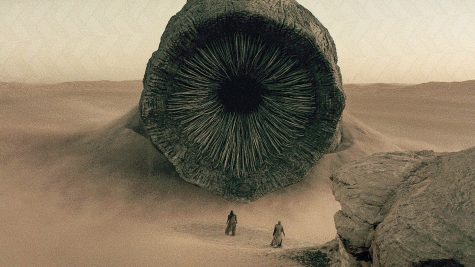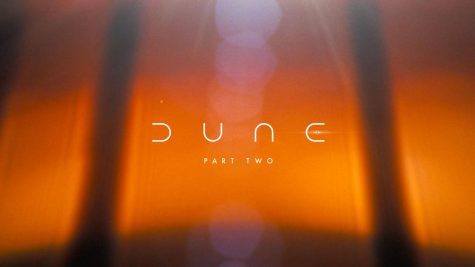‘Dune’: Finally Done Right, Yet Unsatisfying
The 2021 film is half of an Immersive Cinematic Odyssey, with Magic of the Past, Politics of Today, and Technology of the Future
November 10, 2021
There is only one story that has served as inspiration for cult classic stories such as “Star Wars,” “Blade Runner,” “Flash Gordon,” “Game of Thrones,” “The Terminator” and “The Matrix.” The 1965 science fiction novel “Dune,” by Frank Herbert, is a classic that is given messianic status for its influence on pop culture. But most casual viewers and readers haven’t been able to immerse themselves in the rich politics and culture of this 6-part book series. The 2021 film adaptation of the novel is a valiant and successful attempt, from a body of work that has been deemed “unfilmable” for decades.
EXPERIENCE THE DUNE
Canadian filmmaker Denis Villeneuve was tasked with bringing to life the first book in the Dune Saga, “Dune.” The first movie, dubbed Part One, released in both theaters and on HBOMax. While watching this movie in either way is a must for both novel audiences and die-hard fans, the theater experience for this epic film is like none other.
Hans Zimmer’s hypnotic score of crashing percussion and haunting lamentations bring an atmosphere of importance and depth to the plot. While the viewer tries to dissect scenes to comprehend this new universe they are learning about, the music serves as a subconscious tone-setter for audiences to immerse themselves.
The visual buffet that Villeneuve’s work is known for is painstakingly present in “Dune” as well. Freeze any frame while watching this film, and the scale, grandeur, colors, and content of what the audience sees is a truly pleasurable experience. The minimal use of CGI helps the space odyssey seem more grounded and realistic. And any CGI that is present, such as the gigantic sandworms, look eerily realistic and strike real fear in movie-goers’ minds.
SPACE NUNS & SAND MESSIAHS
“Dune” is the definition of a slow-burn story. The story unravels in its own time, not giving audiences all the answers they yearn for immediately. World-building is executed in clever ways that propel the plot forward without too many sessions of info-dumping. Especially when taking into consideration that the story of this first movie is only one-half of the entire novel, the movie has just enough information to cover in its 2 hours and 35 minutes runtime. (Unlike the original 1984 film adaptation of this story.)
A majority of this movie is just exposition, leading to the traditional “climax” of the film to feel lacking and not very impactful. The “final battle” of Part One is not one that we have been anticipating or waiting for, but rather one that will facilitate the remaining plot to be told in Part Two. But even without the standard number of flashy action sequences we’d expect in a science fiction movie of this caliber, we still feel the tension and stakes of the conflict at hand.
The world of “Dune” is drenched in politics, similar to our own. So rather than see buckets of bloodshed (though this movie has its own share of gore), we learn how a few key players within the political chessboard have an effect on the lives of millions. The “emperor” pulls strings from behind the scenes, and each character’s own agenda moves along the plot all within this grand plan.
Villeneuve’s consideration for new viewers is also apparent when he attempts to keep the non-English jargon to a minimum. The audience is able to follow along and gather context clues, rather than being told everything explicitly. He doesn’t insult the intelligence of the audience, but also doesn’t overwhelm them with a world they know nothing about.
With all of the great things about watching this film, comes one slight inconvenience. Much of the jargon used by the characters mixed in with the plethora of accents from each actor makes it hard to understand what the characters are saying in certain scenes of the movie. Subtitles during the movie would’ve been a great help especially when learning about non-English words such as “Bene Gesserit” and “Kwisatz Haderach.”
A STORY OF A SON AND HIS MOTHER
**SPOILERS AHEAD**
In a galaxy thousands of years into the future where humans have gained the technology and means to expand onto other planets, noble houses are given control of certain planets and territories under the rule of an emperor (see where Star Wars gets its inspiration from yet?).
In this world, “spice” is a powder substance that can be mined only from the desert wasteland planet of Arrakis (also known as “dune”). This addictive substance is what powers all space travel, and when ingested, gives the user a longer life span and heightened awareness. The issues of mining spice are 1) the native Fremen who have adapted to thrive in the harsh and unforgiving conditions of Arrakis, and 2) the giant 400 meters sandworms that sense rhythmic movements on sand (such as walking) and eat whatever makes that rhythmic movement.

The House Atreides, one of the powerful houses under the emperor’s rule, is given control of the planet Arrakis and the spice production. We focus on the teenage Paul Atreides (Timothee Chalamet), and his parents, the Duke of Atreides (Oscar Isaac) and Lady Jessica (Rebecca Ferguson).
Issac’s Duke is a composed and wise man, who is a divergence from the trope of a father burdened with responsibilities who doesn’t care about the welfare of his kids. In a heart-to-heart with Paul during the first act of the movie, we are shown how much the Duke actually cares, ushering us to root for the House Atreides and its grandeur. When taking over control of the spice mines, the Duke explains how he would rather form an alliance with the Fremen, than oppress them like the previous overseers of Arrakis did.
The stacked cast also includes a notable performance from Jason Momoa as the swordmaster Duncan Idaho. He brings humor and light-hearted humor to the otherwise bleak and focused plot. The charm and charisma that always comes with Momoa’s characters helps round out the movie into a more enjoyable experience.
But despite the standout cast of well-known actors, many felt underused and underdeveloped, such as Josh Brolin as Gurney Halleck, Dave Bautista as Rabban Harkonnen, and David Dastmalchian as Piter De Vries. Though we can hope to get more character growth from some underused characters, others have been killed off- making that possibility nil.
Before, during, and after the process of the family migrating to Arrakis, the young Paul has repeated visions of a young Fremen woman named Chani (Zendaya). These visions soon verge out to events that happen in the future, and some even start to come true. A few days prior to the group leaving for Arrakis, Paul is hailed by an elder of the Bene Gesserit. The matriarchal group is known for their powers of persuasion, superhuman abilities. They serve as both a religious and political force within the society of Dune. Paul himself is a descendant of the Bene Gesserit, as his mom is a part of the order. This means that the young boy is both a child of the Bene Gesserit arts, and also the sole heir of the Atreides line.
When Paul meets with the elder, he is challenged with a ritual known as the “Gom Jabbar.” A poisonous needle is held millimeters away from Paul’s throat as he undergoes immense pain. He must either control his impulses or die at the hand of the Gom Jabbar. The interesting part of this scene is that we do not see the pain- we simply see the reaction that Chalamet conveys through his acting skills. The young actor expresses his anguish masterfully. And this pattern of impressive performances from Chalamet is prominent throughout the film.
Of course, since this is a hero’s journey epic, the main character is obviously “the chosen one.” As soon as the family lands on Arrakis, the young Atreides starts to hear whispers of the “Kwisatz Haderach.” We soon learn that this is a messiah of sorts to the Fremen people, who have a prophecy of a child of dual heritage (like Paul) being the ultimate superbeing.
The plot thickens as the previous rulers of the spice trade, the Harkonens, attack the newly appointed Atreides at night as revenge. The Duke is killed and both Jessica and Paul escape into the dune.
The film relies heavily on Paul and Jessica’s relationship with one another, and Chalament and Ferguson do a stellar job in executing their roles. Ferguson encapsulates an aura of maternal feelings as well as the omniscient stoicism that is necessary from Bene Gesserit.
After walking for what seems like forever, trekking at night, and trying to avoid the attention of the sandworms, the pair meet a group of Fremen who are living in the desert. This is where we finally meet Chani outside of Paul’s eerie visions of her. She steals the scene with her snarky yet considerate dialogue, and leaves the audience excited to see more of her character in the second installment.
Paul fights for his honor against a Fremen man, wins, and both Atreides’ are absorbed into the community. We leave off here at the end of the first movie.
When the credits roll, you feel as though you’ve watched half of a story— which is true. We can only hope that the second part of this story is told with the same standard and finesse that the first has. The slow and steady pacing of this first half must translate into an eventful and epic journey for Paul in the second half, or the carefully crafted world-building will have been for nothing.
It will be interesting to be able to rewatch both movies back-to-back, and see if they flow well together in terms of pacing and exposition.
VISIONS OF THE FUTURE
As of the time of this review, Part Two of this novel-to-film adaptation has been green-lit. But this was a bit over a week after the movie was released; meaning that there was a possibility that when early watchers saw the movie, they were watching a story that would never be finished. With the second movie currently in the works and scheduled for 2023, new and old fans are ready to see the first part of this saga find a satisfying close.

Though only plans for adapting the first book have been spoken of, it would be pretty easy for Warner Brothers to make a franchise out of the original six-book series. If they decide to go this route (which is very plausible), we can’t help but wonder whether Dune would’ve been a story better told through the medium of television.
EMPEROR’S VERDICT
Dune is a love letter to sci-fi fans. Thus, the intricate political and emotional plotlines, and the confusing jargon can be a turn-off for many. Pair that with the prolonged slow-burn plot, and it’s easy to understand why casual viewers would become bored quickly. But if audiences stick with it and actually pay attention, they’ll find a mesmerizing story that parallels our reality just enough to hook them into the complex world of “Dune.”
